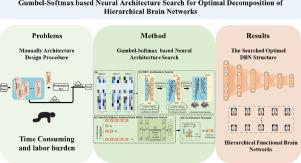Medical Image Analysis ( IF 10.7 ) Pub Date : 2022-08-06 , DOI: 10.1016/j.media.2022.102570 Tianji Pang 1 , Shijie Zhao 1 , Junwei Han 1 , Shu Zhang 2 , Lei Guo 1 , Tianming Liu 3

|
Understanding the brain's functional architecture has been an important topic in the neuroimaging field. A variety of brain network modeling methods have been proposed. Recently, deep neural network-based methods have shown a great advantage in modeling the hierarchical and complex functional brain networks (FBNs). However, most of these deep neural networks were handcrafted, making it time-consuming to find the relatively optimal architecture. To address this problem, we propose a novel unsupervised differentiable neural architecture search (NAS) algorithm, named Gumbel-Softmax based Neural Architecture Search (GS-NAS), to automate the architecture design of deep belief network (DBN) for hierarchical FBN decomposition. Specifically, we introduce the Gumbel-Softmax scheme to reframe the discrete architecture sampling procedure during NAS to be continuous. Guided by the reconstruction error minimization procedure, the architecture search can be driven by the intrinsic functional architecture of the brain, thereby revealing the possible hierarchical functional brain organization via DBN structure. The proposed GS-NAS algorithm can simultaneously optimize the number of hidden units for each layer and the network depth. Extensive experiment results on both task and resting-state functional magnetic resonance imaging data have demonstrated the effectiveness and efficiency of the proposed GS-NAS model. The identified hierarchically organized FBNs provide novel insight into understanding human brain function.
中文翻译:

基于 Gumbel-Softmax 的神经结构搜索用于分层脑网络分解
了解大脑的功能结构一直是神经影像学领域的一个重要课题。已经提出了多种脑网络建模方法。最近,深度神经网络——基于这些方法的方法在分层和复杂的功能性脑网络(FBN)建模方面显示出巨大优势。然而,这些深度神经网络大多是手工制作的,因此寻找相对最优的架构非常耗时。为了解决这个问题,我们提出了一种新的无监督可微分神经架构搜索 (NAS) 算法,名为基于 Gumbel-Softmax 的神经架构搜索 (GS-NAS),以自动化深度信念网络 (DBN) 的架构设计以进行分层 FBN 分解。具体来说,我们引入了 Gumbel-Softmax 方案,以将 NAS 期间的离散架构采样过程重构为连续的。在重建误差最小化程序的指导下,架构搜索可以由大脑的内在功能架构驱动,从而通过 DBN 结构揭示可能的分层功能性大脑组织。所提出的 GS-NAS 算法可以同时优化每层的隐藏单元数和网络深度。任务和静息状态功能磁共振成像数据的广泛实验结果证明了所提出的 GS-NAS 模型的有效性和效率。已识别的分层组织的 FBN 为理解人脑功能提供了新的见解。对任务和静息状态功能磁共振成像数据的广泛实验结果证明了所提出的 GS-NAS 模型的有效性和效率。已识别的分层组织的 FBN 为理解人脑功能提供了新的见解。任务和静息状态功能磁共振成像数据的广泛实验结果证明了所提出的 GS-NAS 模型的有效性和效率。已识别的分层组织的 FBN 为理解人脑功能提供了新的见解。











































 京公网安备 11010802027423号
京公网安备 11010802027423号